Digital Poster
New Approaches in RF Coils II
ISMRM & ISMRT Annual Meeting & Exhibition • 03-08 June 2023 • Toronto, ON, Canada

| Computer # | |||
|---|---|---|---|
4245.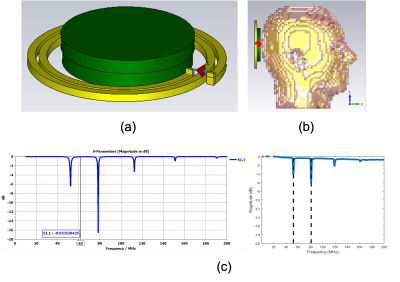 |
161 |
Inductive and capacitive coupling modes of an RF coil to an
ultra-High Dielectric Constant (uHDC) disk resonator
Parisa Lotfi1,
Soo-Han Soon2,
Navid P. Gandji1,
Michael Lanagan3,
Hannes M. Wiesner2,
Xiao-Hong Zhu2,
Wei Chen2,
and Qing X Yang1
1Center for NMR Research, Departments of Neurosurgery and Radiology, College of Medicine, Pennsylvania State University, Hershey, PA, United States, 2Center for Magnetic Resonance Research, University of Minnesota, Minneapolis, MN, United States, 3Department of Engineering Science and Mechanics, Pennsylvania State University, State College, PA, United States Keywords: Non-Array RF Coils, Antennas & Waveguides, High-Field MRI, Coil, Dielectric, coupling, SNR We investigated capacitive and inductive couplings of an RF coil to an ultra-High Dielectric Constant (uHDC) disk resonator with a given resonance mode of similar frequency using simulation and experiments. Coupling of the RF coil and uHDC resonator can result in splitting the resonance into two modes: a parallel mode via inductive coupling and an anti-parallel mode via capacitive coupling. With the two resonators, the stronger and deeper penetration of the resultant B1 field is observed with parallel mode (in-phase) than anti-parallel mode (out-of-phase), which supports that the parallel mode is preferable for coupling uHDC resonators for MRI applications. |
|
4246.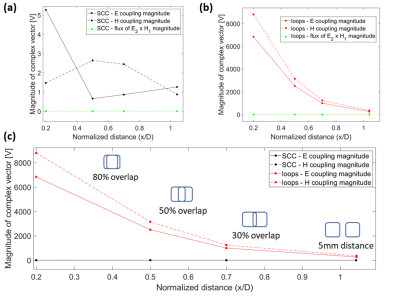 |
162 |
Disentangling coil coupling mechanisms through a Faraday
equivalent model: application to the shielded-coaxial-cable (SCC)
coil at 7T
Giovanni Costa1,
Margarethus Maarten Paulides1,
and Irena Zivkovic1
1Department of Electrical Engineering, Technical University of Eindhoven, Eindhoven, Netherlands Keywords: RF Arrays & Systems, High-Field MRI, Coupling, SCC coils, Faraday's law of induction, SAR reduction Minimizing coupling between coils constitutes a major challenge in the design of flexible arrays for UHF MRI. Recently, Shielded-coaxial-cable coils (SCC) were shown to be flexible and intrinsically highly decoupled: however, the decoupling mechanism of SCC remains unclear. In this work, we use an high frequency Faraday-equivalent model of the induced voltage to examine coupling between two SCCs in different geometrical configurations. We show that lower coupling in SCC derives from both lower magnitude of electric and magnetic fields as compared to a loop coil, and we discuss the implications in the design of coils for MRI. |
|
4247.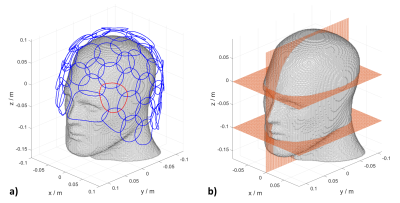 |
163 |
Quasi-Static and Time-Generalized Field Computation Methods
Compared to the Moment Method for Performance Evaluations of
Coil Arrays in PI at UHF
Mirsad Mahmutovic1,
Sam-Luca JD Hansen1,
Manisha Shrestha1,
and Boris Keil1
1Institute of Medical Physics and Radiation Protection, TH Mittelhessen University of Applied Science, Giessen, Germany Keywords: RF Arrays & Systems, Parallel Imaging, Phased Array, Electromagnetic Field Simulations In this study, we compared the quasi-static method (QSM), the time-generalized method (TGM), and the method of moments (MoM) for performance evaluations of coil arrays in parallel imaging (PI) at UHF. We have shown that the QSM and the TGM are a good approximation to the MoM solution, and that all three methods perform similarly in a comparative study with a 64-channel head coil. Furthermore, we could show, that the TGM performs better than the QSM at larger distances in the phantom, which may be beneficial for the evaluation of torso coils. |
|
4248.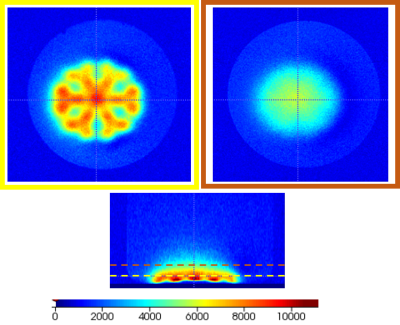 |
164 |
Proof of concept for auto-resonant structure to increase the
field of view of surface coils
Camille Dubuc1,
Clément Thibault2,3,
Faouzi Boussaha4,
Sina Marhabaie5,
Jean-Christophe Ginefri5,
and Marie Poirier-Quinot5
1Universite Paris-Saclay, ORSAY, France, Metropolitan, 2Université Paris-Saclay, CEA, CNRS, Inserm, BioMaps, Orsay, France, 3Université Paris-Saclay, CEA, CNRS, BAOBAB, NeuroSpin, Gif-sur-Yvette, France, 4GEPI - Observatoire de Paris (CNRS 8111), Université PSL, Paris, France, 5Université Paris-Saclay, BioMaps, ORSAY, France Keywords: Non-Array RF Coils, Antennas & Waveguides, Non-Array RF Coils, Antennas & Waveguides, Multi Loop Transmission Line Resonator To improve the performances of High Temperature Superconducting surface coils, it is essential to enlarge their field of view while keeping the sample-induced noise low. New multi-loop designs could help meeting this challenge. In this work, we present a preliminary study on a copper coil. We first introduce the design, electromagnetic simulations, realization of a multi-loop transmission line resonator copper coil and experimental characterizations. Signal to Noise Ratio-maps of the coil are then acquired in a 3T field. |
|
4249.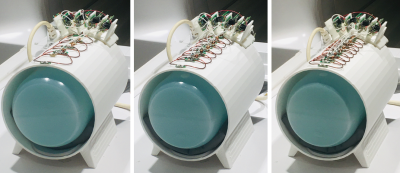 |
165 |
Impacts of Longitudinal Coil Encoding on Simultaneous
Multi-Slice (SMS) Head MRI
Yunsuo Duan1,2,
Feng Liu1,2,
Rachel Marsh1,2,
Mathhew Riddle1,2,
Gaurav Patel1,2,
Alayar Kangarlu1,2,
Lawrence S. Kegeles1,2,
and John Thomas Vaughan Jr.3
1Division of Translational Imaging, Department of Psychiatry, Columbia University, New York, NY, United States, 2MRI Research Center, New York State Psychiatric Institute, New York, NY, United States, 3Columbia MR Research Center, Columbia University, New York, NY, United States Keywords: RF Arrays & Systems, RF Arrays & Systems Coil encoding in the longitudinal direction (z-direction) plays an important role in SMS MRI quality. Although many head coil arrays have been reported, systematic research on impacts of coil encoding in the longitudinal direction on SMS imaging remains insufficient. We present a comparison study of coil encoding for head arrays. Our experimental results showed that, to achieve quality images, the mulitband factor should be equal to or less than the number of coil rows. In extreme cases, the mulitband factor should not exceed 1.5 times the number of coil rows. |
|
4250.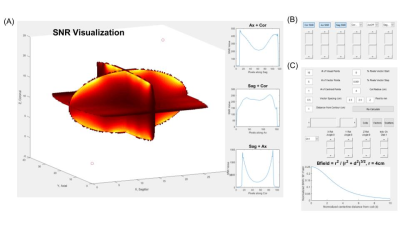 |
166 |
SNR Visualization: A Toolbox for Locating Flexible Coil Arrays
Pulkit Malik1,
Tracy Wynn1,
Peter Fischer1,
and Gillian Haemer1
1InkSpace Imaging, Pleasanton, CA, United States Keywords: RF Arrays & Systems, Data Analysis, Receive Array SNR We present a MATLAB based visualization toolbox for locating coil elements and evaluating SNR for flexible coil arrays. The greater variation in coil positioning creates challenges for SNR comparisons. By locating coils with coil sensitivity isocontours, the SNR of individual channels can be evaluated while the coil array is flexed. This is used to examine the repeatability of placement, and changes to coil coupling in the different placements. The coil locations can be validated using the SNR visualization displayed as slices, lines, and probe points. Expectations of the SNR field shape are used to further optimize coil locations. |
|
4251. |
167 |
MATCHING CIRCUIT CO-SIMULATION FOR MR RADIOFREQUENCY COIL SYSTEM
OPTIMIZATION
Amer Ajanovic1,
Stephen Ogier2,3,
Raphael Tomi-Tricot1,4,5,
Joseph V Hajnal1,4,
and Shaihan Malik1,4
1Biomedical Engineering Department, School of Biomedical Engineering and Imaging Sciences, King's College London, LONDON, United Kingdom, 2National Institute of Standards and Technology, Boulder, CO, United States, 3Department of Physics, University of Colorado, Boulder, CO, United States, 4London Collaborative Ultra high field System (LoCUS), London, United Kingdom, 5MR Research Collaborations, SIEMENS Healthcare Limited, Frimley, United Kingdom Keywords: RF Arrays & Systems, Simulations, RF Pulse Design and Fields, parallel transmit coils We present a full closed form solution focusing on S-parameters to achieve tuning and matching of the coils by extending the circuit co-simulation (CCS) by enabling introduction of arbitrary matching networks into the CCS without requiring full RF simulation of the network. We validate the method against CCS and demonstrate its applicability to evaluate full-field solutions for 5 different coil model using MARIE. |
|
4252.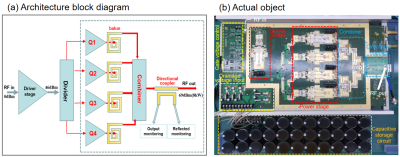 |
168 |
8kw non-magnetic RF power amplifier with four-way combiner for
5T MRI
Jiasheng Wang1,2,3,
Shengping Liu3,
Jifeng Chen1,2,
Xinwei Rong1,2,
Xiaoliang Zhang4,
and Ye Li1,2
1Paul C. Lauterbur Imaging Research Center, Shenzhen Institutes of Advanced Technology, Chinese Academy of Sciences, Shenzhen, China, 2Key Laboratory for Magnetic Resonance and Multimodality Imaging of Guangdong Province, Shenzhen, China, 3Chongoing Universit of Technology, Chongqing, China, 4Department of Biomedical Engineering, State University of New York at Buffalo, Buffalo, NY, United States Keywords: RF Arrays & Systems, RF Arrays & Systems, RF power amplifier Ultra-high-field magnetic resonance requires higher power capability and transmission efficiency. An 8 kW non-magnetic RF power amplifier with four-way combiner for 5T MRI is presented. The whole module adopts non-magnetization design to improve transmission efficiency, and the power of four MOSFETs is combined by a combiner with adjustable balance to meet the output power of 8 kW. |
|
4253.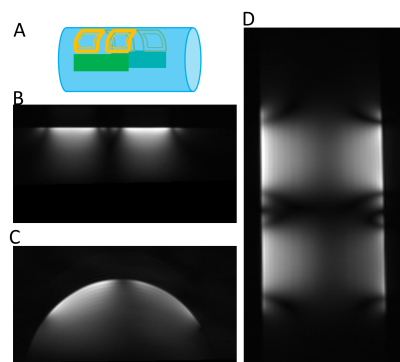 |
169 |
A screen-printed and electroplated 4-channel receiver array coil
for veterinary imaging
Camila Pereira Sousa1,2,
Tony Gerges2,
Florent Dimeglio1,
Jean-Lynce Gnanago2,
Valernst Martial Gilmus2,
Philippe Lombard2,
Hugo Dorez1,
Michel Cabrera2,
and Simon Auguste Lambert 2
1Hawkcell, Marcy l'étoile, France, 2Université de Lyon, INSA Lyon, Université Claude Bernard Lyon 1, Ecole Centrale de Lyon, CNRS, Ampère UMR5005, Villeurbanne, France Keywords: RF Arrays & Systems, RF Arrays & Systems, Animals In this work, we present a 4-channel receiver array entirely dedicated to veterinary imaging. For this purpose, we have fabricated an array coil on a flexible substrate using silver-ink screen printed process and copper electroplating. This flexible and conformable array coil has the potential to improve veterinary diagnosis with small form-fitting elements that allow a better signal to noise ratio performance. |
|
4254.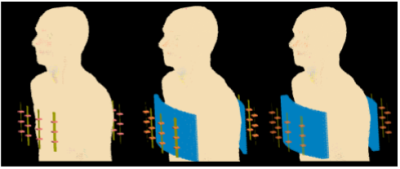 |
170 |
Determination of the Optimum Permittivity of High-Permittivity
Pads when Dipoles are Used as Transmit Coils for the Chest
Giuseppe Carluccio1,2 and
Christopher Michael Collins1,2
1Radiology, NYU Grossman School of Medicine, New York, NY, United States, 2Center for Advanced Imaging Innovation and Research (CAI2R), New York University, New York, NY, United States Keywords: RF Arrays & Systems, RF Arrays & Systems, High-Permittivity Materials High-Permittivity Materials are often used to manipulate the radiofrequency field B1. Optimization of the permittivity depends on the geometry of the pad, of the subject and of the coil. In this work we determine the permittivity of two pads positioned around the torso, having thickness 1.5 cm and 3 cm, when a dipole array is used to provide the highest transmit efficiency in the heart. The pads provide an improvement of the transmit efficiency of 9.5% and 7.6% for the 1.5 cm and 3cm case respectively, while providing a SAR reduction of 20.2% and 12.5%. |
|
4255.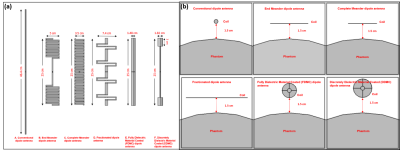 |
171 |
Performance and B1 Efficiency Analysis of Different Dipole
Antenna Types at 7T.
Aditya Ashok Bhosale 1 and
Xiaoliang Zhang1
1Department of Biomedical Engineering, State University of New York at Buffalo, Buffalo, NY, United States Keywords: Non-Array RF Coils, Antennas & Waveguides, Simulations In this work, we compare the performance of several dipole antenna types for MR applications at 7T in terms of quality factor, B1+ strength, SAR, B1+ field pattern, and B1+ efficiency. This study may provide guidance on the selection of an appropriate dipole coil for a specific imaging application. |
|
4256.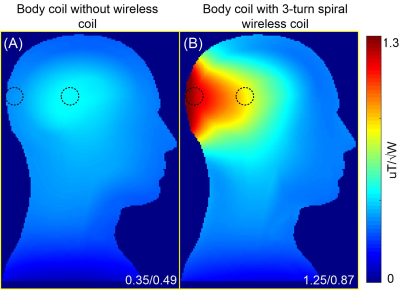 |
172 |
Numerical investigation of multi-turn wireless RF coil for MRI
Ming Lu1,
Xiaoyang Zhang1,
and Xinqiang Yan2,3
1College of Nuclear Equipment and Nuclear Engineering, Yantai University, Yantai, China, 2Vanderbilt University Institute of Imaging Science, Vanderbilt University Medical Center, Nashville, TN, United States, 3Department of Radiology and Radiological Sciences, Vanderbilt University Medical Center, Nashville, TN, United States Keywords: Non-Array RF Coils, Antennas & Waveguides, RF Pulse Design & Fields Standard RF coils require preamplifier models, baluns, coil plugs, and coil ID circuits, which makes coils bulky and expensive. A more affordable way to achieve as high SNR as the standard local receive coil is using the inductively coupled wireless coil. In this work, we numerically investigate whether the multi-turn wireless coil with a similar structure as the stacked coil can enhance the SNR. |
|
4257.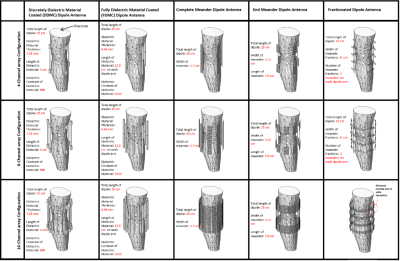 |
173 |
A Systematic Comparison of Different Dipole Antenna Array
Configurations for Knee Imaging Applications at 7T.
Aditya Ashok Bhosale 1,
Leslie Ying1,
and Xiaoliang Zhang1
1Department of Biomedical Engineering, State University of New York at Buffalo, Buffalo, NY, United States Keywords: MSK, RF Arrays & Systems In this study, we investigate different multi-channel array configurations formed by various dipole antenna types and compare the array configurations in B1+ field maps, SAR maps, and inter-element isolation for knee imaging at the ultrahigh field of 7T. |
|
4258.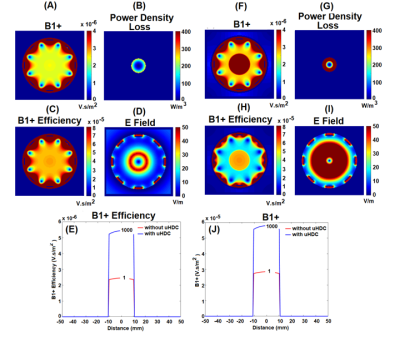 |
174 |
SNR Improvement with Ultrahigh Dielectric Constant (uHDC)
Material for 7T 1H MRS Imaging
Mohan Jayatilake1,
Christopher T Sica1,
Dhevin Karunanayaka1,
Anupa Ekanayaka2,
Biyar Ahmed1,
Rommy Elyan1,
and Prasanna Karunanayaka1
1Pennsylvania State University College of Medicine, Hershey, PA, United States, 2Grodno State medical University, Grodno, Belarus Keywords: High-Field MRI, Challenges We investigated the effects of ultra-high dielectric constant (uHDC) materials for enhancing the B1 field at 300 MHz for potential MRS imaging 1H at 7.0 T. The uHDC material was able to increase the transmit efficiency. We calculated B1+ and B1+ efficiency for a phantom mouse brain with and without uHDC material and empirically obtained nominal flip angle maps and 1H metabolic spectra with and without uHDC. Our results show significant enhancement of Signal-to-Noise ratios (SNRs) of 1H spectra in the presence of the uHDC material. |
|
4259.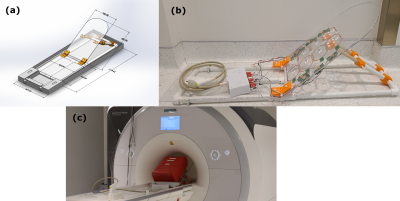 |
175 |
In-bore Reclinable Array for Pediatric Spine Imaging
Charbel Matta1,
Milica Popović1,
and Reza Farivar2
1Electrical and Computer Engineering, McGill University, Montréal, QC, Canada, 2Ophthalmology, McGill University, Montréal, QC, Canada Keywords: RF Arrays & Systems, RF Arrays & Systems We constructed and tested a reclinable MR compatible chair equipped with an 8-channel spine array coil for 3T. The coil used a combination of overlap and transformer decoupling to maximize spatial resolution without modifying individual coil size. The signal to noise ratio and noise correlation matrices were used to compare the performance of the array to a 32-channel commercial array of the same type. The SNR variations were tested with respect to the inclination of the chair. |
|
4260.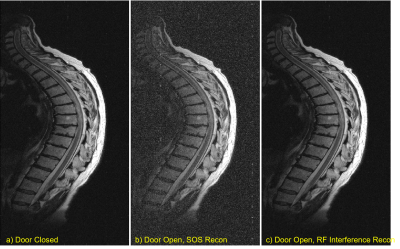 |
176 |
RF Interference Removal in Multi-Channel Receive coil
Harsh Kumar Agarwal1 and
Ramesh Venkateshan1
1GE Healthcare, Bangalore, India Keywords: System Imperfections: Measurement & Correction, Artifacts RF Interference can severely degrade the performance of an MR system. Several solutions such as RF shielding, waveguides and special filters are used to send and receive data to the MRI scanner. These solutions constitute significant part of MR installation and maintenance cost. RF interference in multi-channel receive MR system is strongly correlated across multiple receive channels. This correlation is exploited in this manuscript to remove/suppress the artifacts in the MR images arising due to RF interference. Initials results are demonstrated on 1.5T commercial MRI scanner with data acquired with open RF cage door. |
|
4261.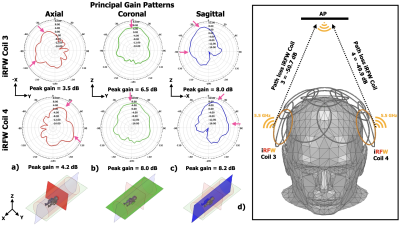 |
177 |
Simulations of an integrated RF/wireless neonatal head coil
array for multiple-input multiple-output (MIMO) wireless MRI
data transmission
Olivia Jo Dickinson 1,2,
Victor Taracila 3,
Devon Karl Overson 1,2,
Spencer R Lynch 1,2,
Beth Reed1,2,
Fraser Robb3,
Allen Song1,2,
Trong-Kha Truong 1,2,
and Dean Darnell 1,2
1Medical Physics Graduate Program, Duke University, Durham, NC, United States, 2Brain Imaging Analysis Center, Duke University, Durham, NC, United States, 3GE Healthcare, Aurora, OH, United States Keywords: Non-Array RF Coils, Antennas & Waveguides, RF Arrays & Systems, WIFI, wireless, neonatal Neonatal neuroimaging can be significantly improved using a form-fitting, lightweight coil array that is untethered from the scanner for a high SNR and reduced setup time. An iRFW coil array does this by performing simultaneous RF signal acquisition and wireless data transfer with the same coil element. Proof-of-concept simulations of a form-fitting soccer-ball geometry 16-channel iRFW coil head array show a high and uniform SNR in the neonatal head and WIFI 6 antenna gain patterns that radiate power outside the bore using a 2x1 multiple-input multiple-output WIFI 6 scheme for the high data rate wireless transmission of MRI data. |
|
4262. |
178 |
A 3T Coil Array for Improved Quantitative Susceptibility Mapping
at Multiple Orientations in ex vivo Primate Brains
Chaimaa Chemlali1,
Dimitrios G. Gkotsoulias2,
Alina Scholz1,
Sam-Luca JD Hansen1,
Torsten Schlumm2,
Roland Müller2,
Carsten Jäger2,
Harald E. Möller2,3,
and Boris Keil1
1Institute of Medical Physics and Radiation Protection, TH Mittelhessen University of Applied Sciences, Giessen, Germany, 2Max Planck Institute for Human Cognitive and Brain Sciences, Leipzig, Germany, 3Felix Bloch Institute for Solid State Physics, Leipzig University, Felix Bloch Institute for Solid State Physics, Leipzig, Germany Keywords: RF Arrays & Systems, Quantitative Susceptibility mapping Quantitative susceptibility mapping (QSM) with multiple object orientations is typically limited by an appropriate examination time that is appropriate for human subjects and the small range of possible rotation angles within an MRI head coil. Ex vivo QSM can overcome these limitations supporting long acquisition times and the ability to rotate the ex vivo specimen to any position. Therefore, a 3T 26-channel ex-vivo brain array coil was developed for fixed chimpanzee brains. The coil was characterized with bench and image metrics and provides increased reception sensitivity, making it well-suited for high-resolution QSM ex vivo MRI studies. |
|
The International Society for Magnetic Resonance in Medicine is accredited by the Accreditation Council for Continuing Medical Education to provide continuing medical education for physicians.